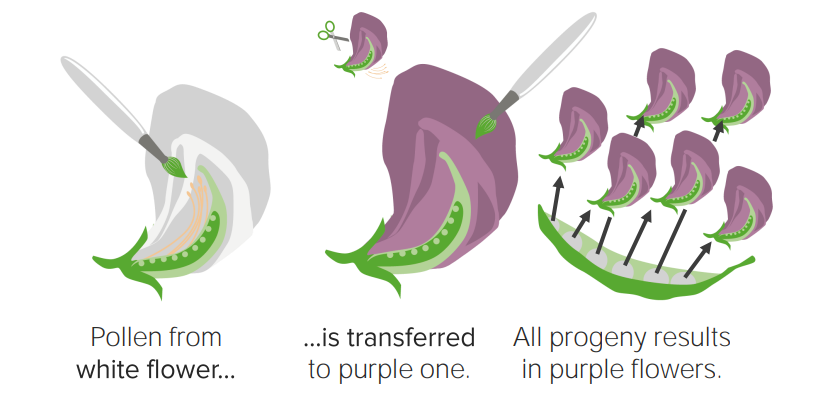Playlist
Show Playlist
Hide Playlist
Quantitative Traits: Risk assessment
-
Slides 01 Multifactorial Inheritance MultifactorialInheritance.pdf
-
Download Lecture Overview
00:01 Those two ways of measuring and assessing relative risk are something that you should keep in mind and be able to calculate lambdas. If we are looking to now calculate the risk of a quantitative trait, we have to use a little bit different of a study. Generally, correlation and heritability studies will be used to determine risk of these sorts of factors. First of all, correlation studies. You've all probably seen a graph very much like this, the scatter plot and the average slope is determined by Y. When we’re considering genetics, we call this the coefficient of correlation or r. I mean I guess we do it any time we’re graphing it. 00:54 The coefficient of correlation is a measure of similarities among relatives. We could have a positive correlation where there is a similarity or a negative correlation by a straight line or downward slope where we do not see perhaps any correlation between family members. Heritability studies are the other measure we can do, we call heritability H2 or H squared, how much variation in a phenotypic trait is actually attributable to genetic variation among individuals as opposed to environmental regulation. 01:38 How do you think we calculate this one? Well, let’s take a quick look. If we have heritability equaling one then all, so 100% of the variation is attributable to genetics or we can have zero where none of it is attributable to genetics or anywhere in between. We can use twin studies to offer insight. 02:08 We have monozygotic, dizygotic twins. I’m sure you are very familiar with the difference between identical and fraternal twins but here is just a reminder. But the point here is that identical twins share 100% of their genetic information. I have in parenthesis here theoretically because as you know, the study of epigenetics is opening up a whole new realm of possibilities. But theoretically we’ll say, I don't want to make absolute statements but theoretically, they share 100%. We’ll just go with that. 02:46 For the cases of your exams, you can stick with that too. Fraternal twins on average, we covered that will contain just like regular siblings, approximately or not approximately, on average 50% depending on who they picked up most similar. I mean whether they picked up more similarity with the mother or father. 03:09 They could be very different or they could be very much more similar. When we look at twins studies, as a reminder, we have everything the same in dizygotic and monozygotic or identical and fraternal twins except for the environmental piece. When we look at monozygotic versus dizygotic concordance rates, we can tell whether there’s a genetic component. Concordance as a reminder, I think you probably would remember that but just in case you don’t, concordance means of twins. If one individual has it then what is the frequency of the other individual having it. You would expect there to be a higher probability in identical twins than you would in non-identical twins if indeed the condition were genetic, right? Here is a table of concordance values that exhibit just that. Once again, you do not need to memorize any of this or again, know which ones are highest but these are some genetically or supposed genetic conditions. 04:27 We may not necessarily know specific genes for but based on twin studies and concordance values, we can tell that there is very likely a genetic component. Now, our mission really is to search for these genes in the genome through the field of genomics and proteomics. We’re going to learn more and more and more and probably more on exponential way as we move forward in genetics. 04:57 To summarize this brief lecture, it was an introduction into how we discern environment from genetic components in many of these multifactorial disorders. As we move forward, we’ll explore some specific multifactorial disorders that you’ll need to know for your exams that we don’t necessarily know the genetic components behind. Then we’ll explore some where we really do have a pretty good understanding of what’s going on. So, I look forward to seeing you there.
About the Lecture
The lecture Quantitative Traits: Risk assessment by Georgina Cornwall, PhD is from the course Multifactorial Inheritance.
Included Quiz Questions
What is the measure of the tendency of two variables to be similar?
- Coefficient of correlation
- Coefficient of heritability
- The correlation constant
- The heritability constant
- The coefficient of concordance
Which of the following r values shows the greatest positive correlation between two variables?
- 1.0
- 0.5
- 2.0
- 0
- -0.5
What would be the value of H2 if all the variation of a phenotypic trait in a population is attributable to genetic variation?
- 1
- 2
- 0
- -1
- -0.5
Which of the following situations offers evidence of the heritability of a trait found in twin studies?
- Monozygotic twins are more likely to have the same traits than dizygotic twins.
- Monozygotic twins are less likely to have the same traits than dizygotic twins.
- Dizygotic twins are more likely to have the same traits than monozygotic twins.
- Monozygotic twins don't have the same traits when raised in different environments.
- Dizygotic twins don't have the same traits when raised in different environments.
Customer reviews
5,0 of 5 stars
| 5 Stars |
|
5 |
| 4 Stars |
|
0 |
| 3 Stars |
|
0 |
| 2 Stars |
|
0 |
| 1 Star |
|
0 |






